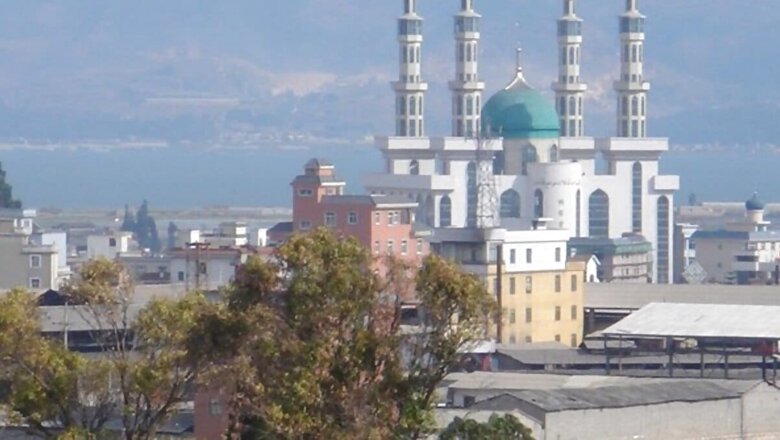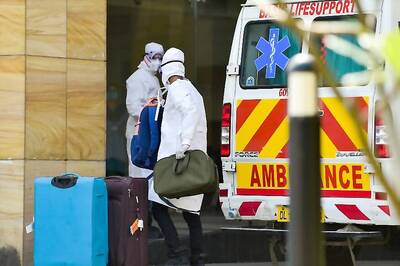
views
The predominantly Muslim town of Nagu in southwestern Yunnan province of China witnessed a rare phenomenon last week. Thousands from the minority Hui Muslim community held protests, clashed with over 1,000 police personnel and forced them to temporarily backtrack plans to alter a 14th century mosque.
The police had a court mandate to dismantle parts of the Najiaying mosque, to which more domes and minarets were recently added. These features are considered to be distinguishing in mosque architecture. The protests were driven by past examples: in Chinese crackdown on places of external religions, the larger objective is to give the structures a Chinese-style architecture by donning it with traditional flooring, wall patterns and roofing similar to Buddhist-style pagodas.
What is worrying and important to note is the fact that the protesters turned violent this time, hurling stones and chairs – something rarely heard of and reported in external media. In doing so, they have not only challenged the local administration and the ideology of the Chinese Communist Party (CCP) but also raised questions on one of the commands directed from the country’s highest office. They have challenged President Xi Jinping’s words and his authority.
What is the ‘sinicisation of religion’ policy?
Jinping’s ‘sinicisation of religion’ policy seeks to transform every religion born outside China in the traditional Han Chinese way. To the outside world, China says its sinicization policy is about realigning external religious values to make them compatible to the socialist core values of the country. The CCP says the motto is never to change the ideology, or Islamic belief system and/or the Muslims residents’ habits.
To the targets inside China, especially Buddhists and Muslims, following religion is almost banned. The sinicisation policy does not allow followers of external religions to perform most religious practices and go for religious teachings. It also does not allow religious-styled architecture, either at homes or outside in community centres.
Jinping coined the term in 2015 and his targets were Islam, Buddhism, Daoism, Catholicism and Protestantism. The clear message was: sinicise them in the Chinese context, socialise and indigenise them. The unspoken directive was: ban most of the non-Chinese religious practices inside China.
Two out of five religions, Buddhism and Islam, were specifically chosen to be targeted. Two independent countries forcefully occupied by China follow these religions and their natives consider themselves different from the CCP’s China and its majority Han population.
Islam is followed by the Uyghur community of the Xinjiang region, the largest province in the current Chinese geographical territory. Tibet, China’s second largest province, is home to Buddhist history, culture and politics.
Who are the Hui Muslims?
According to the Chinese Census 2020, Hui Muslims are China’s fourth largest ethnic group. They are largely located in the Ningxia region, also officially known as Ningxia Hui Autonomous Region (NHAR), in north-central China. The other three ethnic groups in China are 1.29 billion-strong Han Chinese, Zhuang (19.6 million) and the Uyghurs (11.8 million).
The 11.8 million-strong Islamic community has a significant presence across China’s entire northwestern territory, but is also present in many mainland provinces. Yunnan province, where the current crackdown has happened, has around seven lakh Hui Muslims.
Hui Muslims once considered assimilated
They immigrated from Arab and Persian empires to the Chinese border and mainland areas some 1,500 years ago. Most of them are Sunni Muslims practising Sufi Islam and are considered largely assimilated in the Han Chinese culture, speaking Mandarin. Their Islam is considered mostly indigenised and they even intermarry with the Han Chinese. For this reason, the CCP was not too hostile towards their religious practices earlier.
The Hui Muslim population was used as a prop against the crackdown on the Uyghur Muslim community in Xinjiang. The province had around seven lakh Hui Muslims, as per China’s 1990 Census, which reached one million as per the 2010 Census. They were a better propaganda tool with CCP-loyal Muslims in Xinjiang as compared to the native rebel Uyghur Muslim population, to coax them to leave Islam and follow its CCP version.
But Xi Jinping’s CCP doesn’t think so
The CCP, following Xi Jinping’s 2015 core doctrine, does not think that Hui Muslims are completely indigenised and sinicised. They are seen as coming from a different external faith following their religious structures, practices and teaching that needs socialisation and more indigenisation, on the lines of what is being done with Uyghur Muslims in the Xinjiang province.
Xinjiang has few Uyghur mosques left. A report by the Washington-based Uyghur Human Rights Project (UHRP) states that China destroyed 10,000 to 15,000 mosques and religious places between 2016 and 2019. Children are separated from their parents and trained in the CCP ideology, Han culture and Mandarin language. They are even arrested for following Islam and sent to re-education camps that many critics consider concentration camps.
Living in fear?
June 6 is the deadline: the protesters must surrender, or they will be arrested and sent to jails or correctional homes to be re-educated, like over 350 in the Xinjiang province with over a million interns or detained people. In different reports and human rights investigations, the number of arrested people has gone up to 3.5 million.
The act of trying to save their 900-year-old mosque has been labelled as a criminal act, which has disturbed the social order of the area. Is it the beginning of the process to kill their religiosity? Will Hui Muslims, once considered assimilated, join other such concentration camps designed for other Chinese minorities in the Xinjiang region?
Can parallels be drawn with Xinjiang?
The 2009 riots in Urumqi, Xinjiang’s capital city, started as a silent protest movement against the CCP’s ill treatment. Protesters were demanding action against the killing of two migrant Uyghur workers by Han Chinese co-workers in a factory in Shaoguan in China’s southeast. In response, the police carried out a violent crackdown that led to rioting.
In the ensuing riots, both Han Chinese and Uyghur Muslims were killed. The scale of extreme crackdown, being currently witnessed in the region, has its genesis in that year’s violence.
In 2018, after peaceful protests by Hui Muslims in the Ningxia region, a mosque’s demolition was stopped but its domes and minarets were later removed. By 2019, almost every mosque in the rural Ningxia region was altered with its domes and minarets removed and replaced by Chinese architecture and Buddhist-style pagodas.
Protests during such changes were routine. In June 2022, while the administration was demolishing domes and minarets of a mosque in Zhaotong city in Yunnan province, protesting Hui Muslims were beaten up by riot police.
Now, with yet another such protest last week that turned violent, the CCP is likely to take a tough stand on the Hui Muslim community’s religious practices. An NPR analysis wrote back in September 2019, “Since April 2018, Hui mosques have been forcibly renovated or shuttered, schools demolished, and religious community leaders imprisoned. Hui, who have travelled internationally, are increasingly detained or sent to re-education facilities in Xinjiang.”
The CCP may now fasten the pace of internments and subsequent arrests, placing Uyghurs and Hui Muslims in the same basket.


















Comments
0 comment